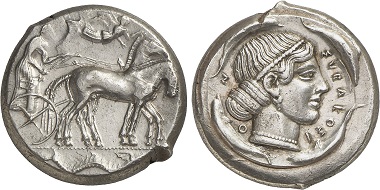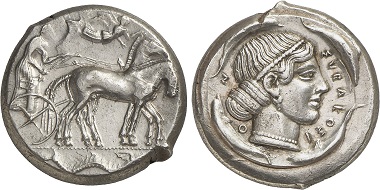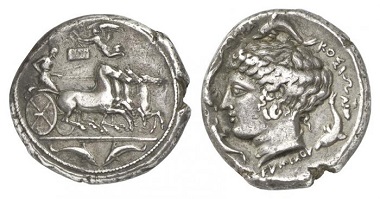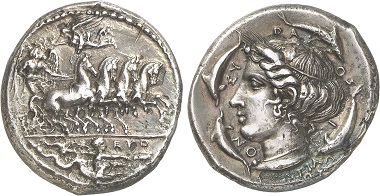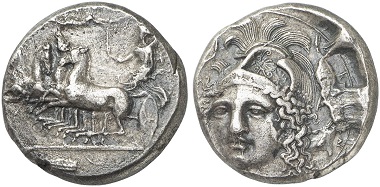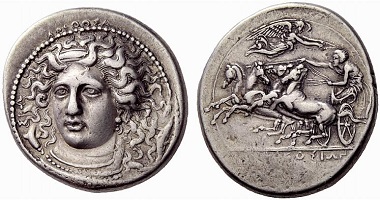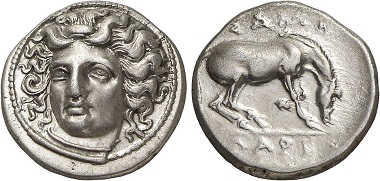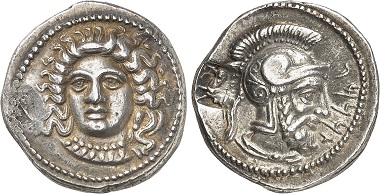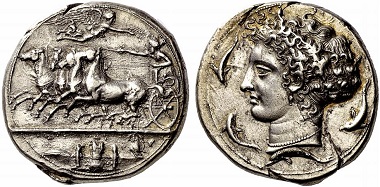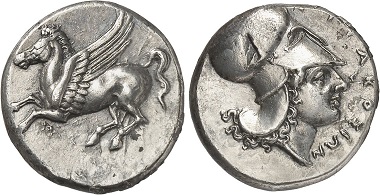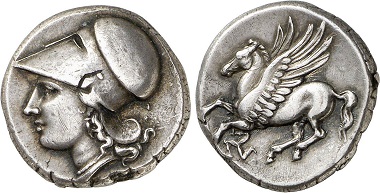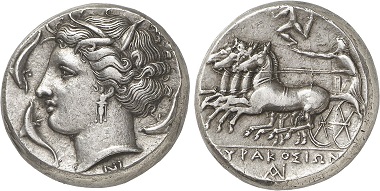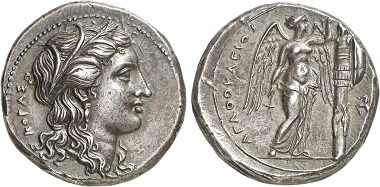Sicilian Mosaic Part 11: The classical coinage of Syracuse
translated by Sylvia Karges
The coins of Syracuse belong to the most beautiful strikings of antiquity. To date, most efforts to link changes in coin design to historical events have failed. And this wasn’t about to change until the time of Timoleon and Agathocles.
Syracuse. Tetradrachm, 450-440. From Gorny & Mosch Auction 236 (2016), 61.
The expulsion of the tyrant Thrasybulus did not bring any significant changes to Syracusan coinage. Still, the image of the victorious quadriga was used on the obverse and Arethusa’s head on the reverse. After 460 the die cutters started to redesign the fountain nymph’s hair displaying various fashionable headdresses, which results in a feeling, that not the common face of a goddess was displayed, but rather portraits of the ladies of Syracusan high society.
Around 415, die cutters in Syracuse and several other Sicilian cities began to sign their works. Simultaneously, the coin design changed slightly: Instead of showing the quadriga on the obverse in walking pace, it was now displayed in a galloping mode.
Syracuse. Tetradrachm, 405-395. From Künker Auction 174 (2010), 130.
The dies of this interesting coin were cut by two different artists. Euainetos created the obverse and Eumenes the reverse. Both artists placed their signatures clearly visible: Eumenes on the reverse below the neck of Arethusa, Euainetos on a little tablet, carried by Nike. This tablet could be associated with the plates victors occasionally consecrated in the sanctuary of a deity. Euainetos used the tablet to place his name quite strikingly within the overall design.
Syracuse. Tetradrachm, 413-409. From Gorny & Mosch Auction 236 (2016), 65.
This is the only preserved obverse die of the die cutter Euth… which, instead of the common charioteer, features the winged god Eros holding the reins. Though this change certainly has meaning, we do not know what conclusions to draw.
On the reverse the female head is decorated with a wreath of ears. This means it’s not Arethusa, but Persephone. She was a daughter of Demeter, whose kidnapping, according to mythology, took place in the vicinity of Syracuse.
Syracuse. Tetradrachm, 413-399. From Künker Auction 262 (2015), 7064.
Eukleidas was the first artist to attempt a frontal portrait. The technology was apparently not yet perfected, as the reverse die had to have cracked quite soon. On the other hand, his work must have been highly valued, because minting was continued even with a cracked die.
A connection between the image of Athena and the victory over the Athenian army could be easily drawn, however this is impossible to prove. Also, Athena was worshipped in Syracuse and an important temple was dedicated to her there.
Syracuse. Tetradrachm, 406-400. From Numismatica Ars Classica Auction 54 (2010), 56.
With this frontal portrait of the fountain nymph Arethusa, Kimon created an image which found imitators in the entire Greek region for centuries. First on Sicily itself, and later throughout all of the Greek cultural area.
Larissa (Thessaly). Drachm, 350-300. From Gorny & Mosch Auction 224 (2014), 169.
These are two examples from the fourth century. One coin derives from Larissa in Northern Greece, …
Tarsus (Cilicia). Datames. Stater, 378-372. From Gorny & Mosch Auction 237 (2016), 1489.
… the other from Tarsus, located in modern south Turkey. This coin type is a great example of how important Syracusan strikings were to the development of various, frequently reoccurring types of representations on coins. It also indirectly points out how widely known the Sicilian coin types were.
Syracuse. Decadrachm, 404-400. From Numismatica Ars Classica Auction 66 (2012), 12.
Shortly before 400, during the reign of Dionysius I, the artist Kimon created the die for this decadrachm. In the exergue of the obverse a group of weapons is displayed, referred to as “Athla” (= fighting prize), a word, which by the way, is related to the English term “athlete”. For a long time, scholars tried to figure out which weapons are shown. Early research thought of them as trophies from the war against Athens, later used as prizes in competitions. Another theory describes them as being a sign of victory erected after the triumph over Athens. Probably though, they are simply weapons offered as prizes at competitions.
Syracuse. Didrachm, 344-317. From Gorny & Mosch Auction 237 (2016), 1170.
In the first half of the 4th century many Sicilian cities had stopped minting coins. This “coin vacuum” was filled by Corinthian staters, which once came into the country as means of payment for wheat. In fact, Corinthian coinage was so widespread on Sicily that most hoard finds, buried between 340 and 290, consisted of more than 70% Corinthian staters. No wonder, then, that the Corinthian Timoleon, under whom the above pictured coin was minted, applied the Corinthian weight and type to his coins.
Syracuse. Didrachm, 317-289. From Gorny & Mosch Auction 224 (2014), 77.
Even 20 years later, under Agathocles, this coin type was still in use. The triskeles mintmark reresents Sicily. It was first applied on coins of Timoleon.
Syracuse. Tetradrachm, 310-300. From Gorny & Mosch Auction 236 (2016), 81.
Under Agathocles, we don’t find the same creativity influencing the whole of the Greek world as it did around 400. Die cutters were imitating their more inventive colleagues. This obverse is a copy of an Euainetos decadrachm, but in a more tired and flat style.
Syracuse. Tetradrachm, 305-295. From Gorny & Mosch Auction 228 (2015), 37.
This coin, on the other hand, presents a new design, entirely in the Hellenistic style. In 310 Agathocles, in a brilliant move, dared to attack Carthage. He dedicated his fleet, used to cross over the Mediterranean, to Demeter and Kore; the latter being depicted on the obverse. After arriving in Carthage, he burned all his ships in order to avoid a fleeing army should he lose.
Prophetically, the reverse shows Nike erecting, as a sign of victory, a trophy, consisting of a tropaion made of weapons, and – a completely new innovation on Syracusan coinage – the name of the minting authority: Agathocles. As regards the history of thought, this tetradrachm is something totally new on Sicily. It is not the gods, and therefore the whole of the state dominating the obverse as motifs, but the successes of a single man. A logical consequence of this is the assumption of the title of King of Agathocles in 304, which would henceforth appear on his coins.
In the following part, we will talk about the coinage of Naxos and Leontinoi.
This article was originally published in MünzenRevue 4/1997.
Please find all parts of this series in our archives.
If you are interested in Sicily, you should certainly check out the numismatic diary “Sicily in full bloom”. Find this series also in our archives.







